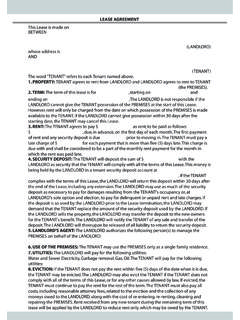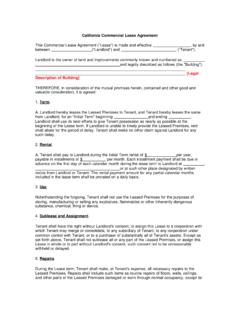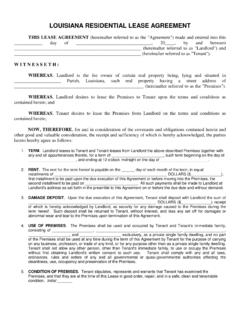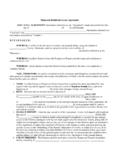Transcription of SUBORDINATION, NON-DISTURBANCE AND ATTORNMENT …
1 subordination , NON-DISTURBANCE AND ATTORNMENT AGREEMENTS:Meeting the Legitimate Goals of Landlords, Tenants and Lenders; Negotiation TechniquesDouglas J. Sanderson1 McCandlish & Lillard, , the course of negotiating leases, one of the issues most often left for the end of the process isthe priority of the tenants rights relative to present and future property financing. Similarly, in the courseof negotiating and closing real estate secured loans, one of the issues most often left for the end is thepriority of the loan security relative to existing and future tenants are these issues often left for the end? Human nature, perhaps. When the landlord and thetenant are negotiating a lease, they are focused primarily on reaching agreement on the financiallysignificant business terms of their lease, relative to each other, and do not have specific lenderrequirements on the table, unless the existing lender has already provided them to the landlord in anyexisting loan documents, which is not usually the case, or unless specific covenants already exist in theloan documents.
2 The rights of landlord s lender upon some future financing, as the landlord may viewit, or upon a foreclosure of landlord s property are just not paramount in the minds of either landlord ortenant during lease negotiations. This is likewise true for a property owner and the secured lender that arenegotiating or closing the loan, relative to the rights of tenants or of other secured creditors. In each casethe immediacy of the principal parties concerns relative to one another is more significant than theirconcerns regarding third parties. In each case, however, wise parties (translation: parties withconsiderable leasing and/or lending experience or parties represented by competent legal counsel) willensure that they do focus on the rights of the affected third parties early enough to consider carefully thebenefits that all can gain from doing subordination , NON-DISTURBANCE and ATTORNMENT agreement (commonly abbreviated as an SNDA agreement ) is the document that the landlord, tenant and lender often employ to resolve howtheir rights do and will intersect.
3 As its name infers, the SNDA agreement addresses how and when therights of tenants will be subordinate to the rights of lenders or, sometimes at lender s option, senior to therights of lenders. It assures tenants that their rights to their premises will be preserved (that is, non-disturbed ) on defined conditions within their control, even if the landlord defaults on its loan and thelender forecloses. The final component of the SNDA agreement assures a lender, generally, that thetenant will attorn to (that is, confirm privity of contract by agreeing to continue as tenant of the newlandlord) the lender or a purchaser following a foreclosure, and that, often but not always, the lender orsuch purchaser will have certain specified rights thereafter.
4 The SNDA agreement also can be used toconfirm or modify rights and obligations far beyond those that are summarized in this , for foreclosure purposes, is what is often called an automatic foreclosure state. Atrustee s sale under a deed of trust (which frequently is referred to as a foreclosure ) in an automaticforeclosure state terminates all property interests, such as leases, that are junior in priority to the deed of 1 (Copyright 2002, by Douglas J. Sanderson.) The author appreciates the assistance of Sunjeet Randhawa, a formersummer associate at McCandlish & Lillard, in Fairfax, Virginia, in researching these materials; of John , Esquire, of First American Title Insurance Company in Chicago, Illinois, who encouraged me to peruse anduse his impressive accumulated file concerning SNDA s.
5 And of Joshua Stein, Esquire, of Latham & Watkins inNew York, New York, who e-mailed me his own substantial writings on this subject and provided me permission touse them if and as Appendix 1 contains a chart, provided in an article written in 1989, regarding which states are automatic foreclosure states it is about half of the country -- and which states allow a lender to pickand choose the leases it wants to retain upon foreclosure. This chart is useful in determiningpreliminarily, at least, the lease termination law applicable upon foreclosures in other jurisdictions, eitherwhen negotiating leases or loans governed by the laws of those states or when researching these legalissues further. For example, according to the chart, the District of Columbia is also an automaticforeclosure jurisdiction, while Maryland allows lenders to pick and choose.
6 While determining whichlegal approach to foreclosure applies in the jurisdiction where the property is located obviously issignificant in determining what one s client wants to or can accomplish in negotiating its legal documents,it merely sets the stage on which the key players usually a lender, a landlord and the tenant(s) have thepower and ability to negotiate the priorities of loans and leases relative to each PURPOSES AND TYPICAL OBJECTIVES OF THE PARTIES IN AN SNDA:To understand the usefulness of subordination , NON-DISTURBANCE and ATTORNMENT agreements, firstconsider that, without SNDA agreements and, as to some states, ignoring any statutes affecting the rightsof, mainly, lenders and tenants upon a foreclosure, the priorities of the lender, tenant and landlord wouldbe determined solely on the basis of the concept of first in time priorities.
7 That is, a tenant that had noticeof an existing deed of trust (including, of course, the constructive notice deriving from recordation) andthen signed a lease would be subordinate to the terms of the deed of trust and, thus, the rights of thelender therein; a foreclosure of that deed of trust would foreclose the rights of the tenant also. However, alender that had notice of an existing lease would be subordinate to the terms of the lease, therefore aforeclosure would not foreclose the rights of that existing tenant. In other words, the results would beeasily determinable, but, in a sense, random, in that only priority in time, and not any good businessreasons, would determine whether a tenant would retain or lose its use of its leased premises, or whether aforeclosure would terminate or leave standing a tenant s executing an SNDA agreement, the three interested parties can agree on how to de-randomize the effects of a foreclosure, refinance or sale of secured and leased property on theirrespective legitimate business objectives.
8 How and when does the need for an SNDA agreement becomean issue? First this paper will examine the lender s considerations and objectives, which usually are adriving consideration in the SNDA agreement negotiations. Adverse positions that a landlord or tenantmight take will become obvious as to many of the lender s preferences that are presented. Subsequentsections will focus more on the considerations and objectives of the tenant and of the Lender Considerations and ObjectivesThe owner of real property containing nonresidential leases will determine, at some point, that itwants or needs a new loan, and will know or learn that the prospective lender requires any loan to besecured against the real estate. As a key component of the lender s evaluation of the creditworthiness ofthe landlord, the lender carefully will examine the value of the property as collateral.
9 The property svalue, in turn, will be determined in large part by the revenues generated from the tenant leases on theproperty. The lender therefore will take lease revenues into account, but also will want assurances thatthose revenues will both remain in effect for a substantial period of time and will be available to aprospective foreclosure purchaser in the event that the landlord defaults in its loan obligations to thelender. 2 See, , Schmidt & Wilson v. Carneal , 164 Va. 412, 180 325 (1935) and Nagle v. Syer , 150 Va. 508, 690 (1928). See, generally, 13A MICHIE S JURISPRUDENCE, Mortgages and Deeds of Trust lender will likely review the tenant leases upon the property, or at least those that are mostsignificant to its credit evaluation, to determine their key provisions relating to rent amount and duration.
10 They may also look for any lease provisions providing for automatic subordination and attornmentobligations of the tenants, and for any obligations of the tenants to sign estoppel Then, thelender will require that the landlord procure tenants signatures on the lender s own required or preferredforms of estoppel certificates and, when any material leases predate the prospective loan, of subordinationand ATTORNMENT agreements (whether use of the lender s forms is required or merely preferred isusually determined by the bargaining power and position of the landlord relative to the lender). Notice,though, the desire of the lender to procure subordination and ATTORNMENT agreements, not subordination , NON-DISTURBANCE and ATTORNMENT agreements. The lender s main objectives are (1) to re-prioritize the leases into either fully subordinate or electively subordinate positions relative to the deed oftrust to be recorded and any subsequent amendments, modifications and extensions of it, and (2) to ensurethat the tenant is committed to recognize the lender or any purchaser at foreclosure ( , to attorn).




